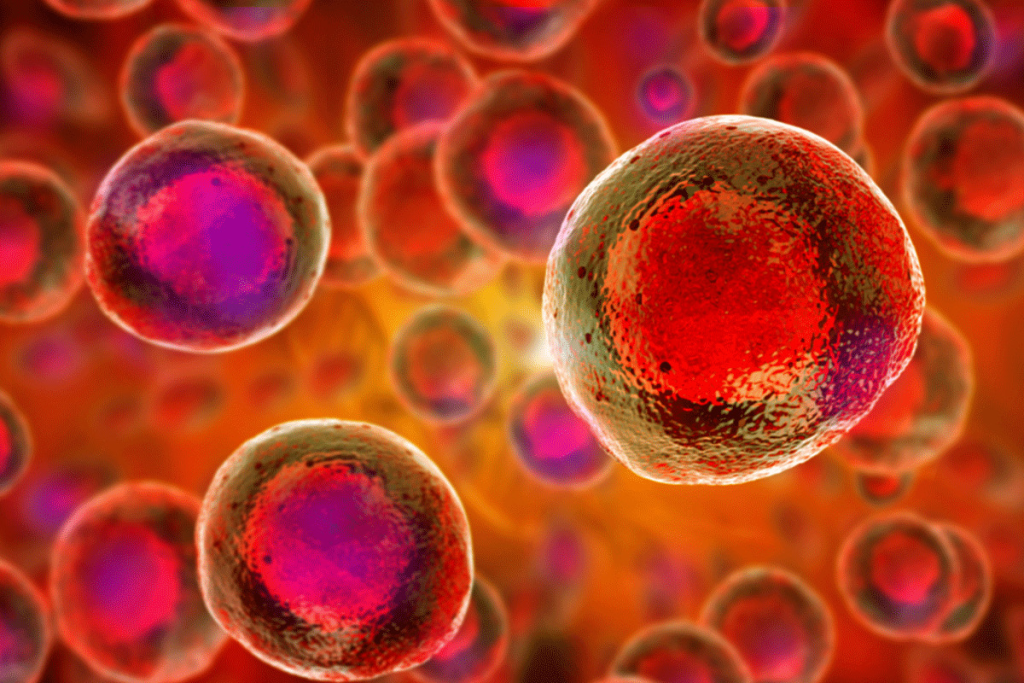Last Updated on October 20, 2025 by
is a groundbreaking field in medicine. It aims to treat many conditions, including rare diseases and some cancers. It makes specific changes to a person’s genes to cure or treat diseases. Even though genetic editing it’s not completely banned, it’s strictly regulated because of its risks and ethical issues.

We’re on the verge of a new medical era with gene therapy. The FDA has approved some gene therapy products. Yet, the rules for gene therapy research differ greatly around the world.
Gene therapy is not banned; it’s heavily watched by strict rules. By 2025, over 30 gene therapy products will have received FDA approval for specific diseases. This shows the tough steps needed to make these treatments available.

Many think gene therapy is banned because they don’t understand the rules. The FDA is key in checking gene therapy’s development, testing, and approval. This makes sure these treatments are safe and work well before reaching patients.
Regulatory bodies like the FDA look at clinical trial data, how it’s made, and labels. They make sure everything follows the rules. This careful check helps lower risks in gene therapy.
It’s important to know the difference between rules and bans in gene therapy. While some gene editing is banned for safety and ethics, gene therapy for treating diseases is watched but not banned.
The rules allow gene therapies for specific diseases to be developed and approved. For example, the FDA has approved gene therapies for severe combined immunodeficiency and some leukemias.
Understanding the nuances between rules and bans is key. Recognizing that rules help make gene therapies safe lets us support innovation. This way, we ensure patient safety while pushing forward in this field.
In 2025, patients will have access to many FDA-approved gene therapies for different genetic disorders. Gene therapy is a promising treatment for several diseases, bringing hope to patients worldwide. We will look at the approved therapies, their areas of treatment, target diseases, and success rates.
The FDA has approved over 30 gene therapy products, a big step in genetic engineering. These therapies target somatic cells, the body’s tissues, not sex cells. This ensures the genetic changes are not passed on, addressing concerns about germline editing.
Some notable therapies include treatments for rare genetic disorders, certain cancers, and inherited vision loss. For example, Luxturna and Zolgensma are known for their innovative treatments of severe genetic conditions.

Gene therapy products approved by the FDA in 2025 cover many areas, including:
These areas show the wide range and promise of gene therapy in treating complex conditions.
Clinical trials and post-marketing surveillance have shown good results for many gene therapies. For example, Zolgensma has greatly improved survival and motor function in infants with spinal muscular atrophy. Luxturna has also restored vision in patients with inherited retinal dystrophy.
“The approval of these gene therapies represents a breakthrough in the treatment of genetic diseases, opening new possibilities for patients and their families.”
NATIONAL INSTITUTES OF HEALTH
As gene therapy advances, we can expect better treatment outcomes and more areas of treatment. The success of these products highlights the need for ongoing research and investment in genetic engineering.
Gene therapy research is on the verge of a breakthrough in medicine. Over 1,300 clinical trials are underway, showing a big push in research worldwide. This is thanks to new genetic editing tools and a better understanding of genetic diseases.

So many clinical trials highlight the growing interest in gene therapy. These trials cover many areas, like rare genetic diseases, cancer, and heart conditions. Gene therapy’s ability to tackle genetic diseases at their source is a key reason for this research.
Trials range from early phases checking safety and effectiveness to later phases looking at long-term results. This wide range of research is essential for moving the field forward and helping patients.
Gene therapy research isn’t spread out evenly around the world. Some places and institutions are leading the way as research hotspots. They get a lot of funding and have top-notch research facilities. Big pharma, governments, and private investors are backing this research, seeing its huge healthcare promise.
The United States, Europe, and parts of Asia are leading in gene therapy research. Top research centers and biotech hubs in these areas are leading the charge. They’re working with industry partners and exploring new possibilities in gene therapy.
Looking at the global gene therapy research scene, we see a lot of promise. With so many trials, innovative research spots, and lots of funding, gene therapy is set to become a key medical treatment.
Gene therapy uses tools like CRISPR to make changes in cells. These tools have changed genetics, allowing for precise genome changes.

CRISPR is a powerful tool for editing genomes. It lets scientists change DNA with great precision. In humans, CRISPR has fixed genetic mutations that cause diseases.
For example, scientists have used CRISPR to treat sickle cell anemia. They edited the gene that causes the disease.
“CRISPR technology could change how we treat genetic diseases,” say some top researchers. “It could cure diseases that were once untreatable.”
CRISPR is not the only tool being used. Other methods include:
Each method has its own benefits and drawbacks. Researchers are always trying to make them better and safer.
Getting genetic tools to the right cells is a big challenge. Different methods and vectors are used, like:
The choice of method depends on the application and the cells being targeted. Researchers are working to make delivery systems better and safer.
In conclusion, genetic editing technologies are key in gene therapy. They offer hope for treating genetic diseases. As these technologies improve, we can expect big changes in the field.
Heritable genome editing has caused a lot of debate worldwide. It involves making permanent changes to human genes. These changes can be passed on to future generations.
Germline editing changes genes in reproductive cells or early embryos. This is different from somatic cell therapy, which targets non-reproductive cells. Somatic cell therapy does not affect the genetic makeup of offspring.
Germline editing is controversial because it can introduce permanent changes to the human gene pool. On the other hand, somatic cell therapy is seen as more acceptable. It aims to treat diseases in the individual without passing on the modifications.
Modifying human embryos for reproductive purposes is heavily restricted in many countries. This is due to ethical and safety concerns. These restrictions aim to prevent the misuse of gene editing technologies, like creating “designer babies.”
“The clinical use of germline editing for reproduction is currently not recommended until its safety and efficacy have been thoroughly evaluated.”
One big concern with heritable genome editing is its transgenerational implications. Changes made to the germline can be passed on to future generations. This could lead to unforeseen long-term consequences.
We need to think carefully about these implications. We should also keep talking about the ethics and safety of such technologies. A pioneer of CRISPR technology said, “The power to edit genes comes with a great responsibility to use this technology wisely.”
Leading gene therapy groups have called for a 10-year ban on editing human genes in 2025. This move sparks debate on the ethics and safety of genetic editing.
The Alliance for Regenerative Medicine (ARM), the International Society for Cell and Gene Therapy (ISCT), and the American Society for Gene and Cell Therapy (ASGCT) have spoken out. They urge a global pause on editing human genes. These groups include researchers, doctors, and industry experts.
Together, they stress the need for a unified global approach to genetic editing. They aim to ensure gene therapies are developed and used ethically and safely.
The 10-year moratorium extension is based on several reasons. It addresses concerns about the safety and effectiveness of genetic editing. Despite CRISPR’s progress, there are doubts about its long-term effects on the human genome.
It also gives time for more research and discussion. The moratorium lets scientists study genetic editing’s benefits and risks. It also allows for deeper ethical and societal debates.
Setting up a global moratorium on genetic editing is a big challenge. It needs national laws, international rules, and professional codes. Organizations are working on stronger systems to check compliance and handle breaches.
Success depends on teamwork between governments, international groups, and scientists. Together, they can uphold the moratorium and guide gene therapy development ethically.
Gene therapy comes with risks, like off-target mutations and unintended effects. It’s important to know these safety concerns and limitations as we explore its use.
Off-target effects are unwanted changes to the genome. They can disrupt other genes or regulatory elements. For example, CRISPR-Cas9 gene editing has shown off-target effects, but their frequency and severity are being studied.
Mitigating Off-Target Effects: Scientists are trying to make gene editing tools more precise. They’re improving CRISPR-Cas9 and exploring new techniques like base editing and prime editing to reduce these effects.
Gene therapy’s long-term effects are not well understood. It’s a new field, and we have little data on its long-term outcomes. This raises questions about possible delayed adverse events or benefits.
Ongoing Monitoring: To address these concerns, regulatory agencies and researchers are conducting long-term studies. These studies are essential for understanding the therapy’s long-term effects and identifying any risks.
Gene therapy has faced setbacks, including adverse events in clinical trials. One example is Jesse Gelsinger, who died in 1999 from a severe immune reaction to a gene therapy vector. Such incidents show the need for strict safety protocols and careful patient selection.
Learning from the Past: The gene therapy community has learned from past setbacks. This has led to better safety measures and stricter regulations. These advancements aim to reduce risks while increasing the therapy’s benefits.
Gene therapy is advancing fast, bringing up big ethical questions. We’re looking at the good and bad sides of changing our genes. It’s important to think about how these changes affect us and society.
Changing our genes raises big questions about consent. We’re making choices that affect not just us but our kids and future generations. It’s hard to decide for people who haven’t been born yet.
Using CRISPR gene editing in humans makes these concerns even bigger. It lets us make precise changes to our genes.
There’s also worry about eugenics and designer babies. Gene selection could lead to a world where some people have more advantages than others. This could make social gaps even bigger.
The real issue is how we use this technology and who gets to use it. We might start valuing certain genes more than others, leading to genetic bias.
Access and equity are key concerns. Gene therapy is expensive and complex. It might only be for those who can pay, widening the gap between the rich and the poor.
We need to make sure genetic editing benefits everyone. This means making treatments affordable and available to more people. We should ensure that not just the wealthy get to enjoy its benefits.
In conclusion, the ethics of genetic modification are complex. As we progress with gene therapy, we must be careful. We need to weigh the benefits against the need to protect everyone’s rights and dignity.
Gene therapy is growing fast, and countries are setting their own rules. These rules vary a lot, showing different views on genetic engineering. They also show how comfortable each country is with this new tech.
In the U.S., the FDA oversees gene therapy under two laws. The FDA’s Center for Biologics Evaluation and Research (CBER) checks if these therapies are safe and work well. They have rules for testing and making these therapies.
Key aspects of the U.S. regulatory framework include:
The European Union has its own rules for gene therapy, mainly through the European Medicines Agency (EMA). The EMA makes sure these medicines are safe and work as they should. The EU’s rules help develop gene therapies while keeping people safe.
Notable features of the EU’s approach include:
Asian countries like China, Japan, and South Korea are playing big roles in gene therapy. They are setting their own rules, which are getting stricter to keep things safe and effective.
Key trends in Asian gene therapy regulation include:
As gene therapy grows worldwide, knowing about these different rules is key. Even though rules vary, everyone aims to make sure these therapies are safe and available to those who need them.
The growth of gene therapy worldwide has shown big gaps in rules across countries. This makes it hard to use these therapies safely and well. We need the same rules everywhere to help.
One big issue is that rules for gene therapy vary a lot from country to country. For example, a therapy approved in one place might not be in another. This makes it tough for researchers and patients to know what to do.
A study in Frontiers in Plant Science shows how different rules can slow down and limit access to gene therapies.
The different rules affect how therapies are approved and tested. They also impact how these treatments are watched after they’re used. This can mean some patients can’t get treatments that could save their lives.
Medical tourism adds more complexity. Patients travel to get treatments not available at home. But it raises worries about the safety and how well these treatments work.
It’s hard to make sure rules are followed when treatments are given in different countries. To fix this, countries need to work together and make rules that are more alike. This would help keep patients safe and move these new treatments forward.
Gene therapy is a complex field that needs careful balance between innovation and ethics. It has the power to change how we treat genetic diseases. But it also brings up big questions about modifying human genes.
We must watch over the growth of these technologies closely. This means dealing with problems like unintended effects, long-term risks, and making sure everyone has access. By doing this, we can use gene therapy to help patients while keeping ethics in mind.
Our journey ahead needs a thoughtful approach. We must encourage new ideas but also protect against dangers. It’s key to be open, work together globally, and keep checking how gene therapy affects us. This way, we can make the most of gene therapy to change healthcare for the better.
Gene therapy uses genes to treat diseases. It’s not banned, but it’s closely watched. This is because of its risks and ethical questions.
Germline editing changes genes in reproductive cells, affecting future generations. Somatic cell therapy changes genes in non-reproductive cells, not passed on.
Gene therapy faces challenges like off-target mutations and long-term effects. It’s a new field, needing more research to understand its benefits and risks.
CRISPR gene editing is a precise gene editing tool. It’s used in gene therapy to treat genetic disorders by altering the genes.
Gene therapy rules vary worldwide. In the U.S., the FDA oversees it. The European Union has its own rules. Other countries have their own guidelines.
The moratorium is a voluntary pause on editing the human genome for heritable changes. It was extended for 10 years due to safety and ethics concerns.
Genetic modification raises questions like consent for future generations. It also brings up concerns about eugenics and fairness in access.
Gene therapy faces risks like off-target mutations and long-term effects. Past trials have shown the need for strict rules and oversight.
Gene therapy rules differ across countries. There are challenges with international consistency and the rise of medical tourism.
Gene therapy research is growing fast, with over 1,300 trials worldwide. It holds promise for treating genetic disorders, cancer, and more.
Gene therapy employs various editing tools, like CRISPR. The choice depends on the treatment’s goals and the condition being treated.
Gene therapy uses different ways to get genes into cells. This includes viral and non-viral vectors, and other methods.
Subscribe to our e-newsletter to stay informed about the latest innovations in the world of health and exclusive offers!